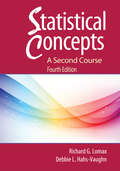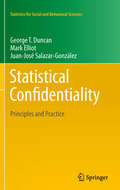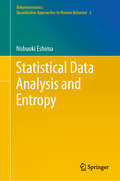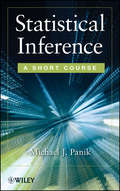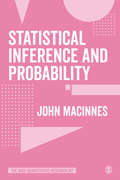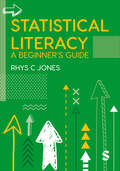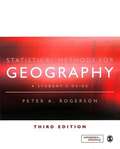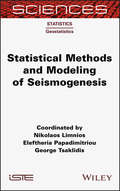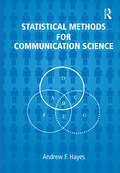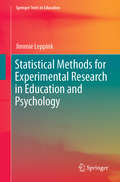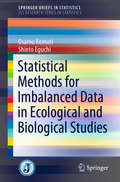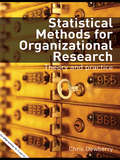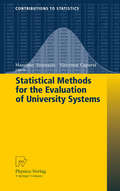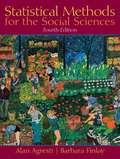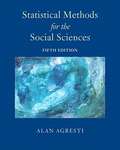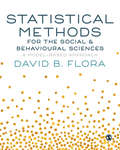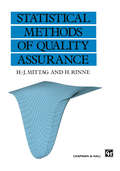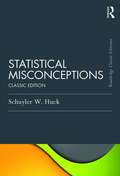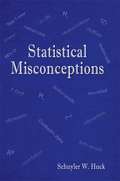- Table View
- List View
Statistical Concepts: A Second Course
by Debbie L. Hahs-Vaughn Richard G. LomaxStatistical Concepts consists of the last 9 chapters of An Introduction to Statistical Concepts, 3rd ed. Designed for the second course in statistics, it is one of the few texts that focuses just on intermediate statistics. The book highlights how statistics work and what they mean to better prepare students to analyze their own data and interpret SPSS and research results. As such it offers more coverage of non-parametric procedures used when standard assumptions are violated since these methods are more frequently encountered when working with real data. Determining appropriate sample sizes is emphasized throughout. Only crucial equations are included. The new edition features: New co-author, Debbie L. Hahs-Vaughn, the 2007 recipient of the University of Central Florida's College of Education Excellence in Graduate Teaching Award. A new chapter on logistic regression models for today's more complex methodologies. Much more on computing confidence intervals and conducting power analyses using G*Power. All new SPSS version 19 screenshots to help navigate through the program and annotated output to assist in the interpretation of results. Sections on how to write-up statistical results in APA format and new templates for writing research questions. New learning tools including chapter-opening vignettes, outlines, a list of key concepts, "Stop and Think" boxes, and many more examples, tables, and figures. More tables of assumptions and the effects of their violation including how to test them in SPSS. 33% new conceptual, computational, and all new interpretative problems. A website with Power Points, answers to the even-numbered problems, detailed solutions to the odd-numbered problems, and test items for instructors, and for students the chapter outlines, key concepts, and datasets. Each chapter begins with an outline, a list of key concepts, and a research vignette related to the concepts. Realistic examples from education and the behavioral sciences illustrate those concepts. Each example examines the procedures and assumptions and provides tips for how to run SPSS and develop an APA style write-up. Tables of assumptions and the effects of their violation are included, along with how to test assumptions in SPSS. Each chapter includes computational, conceptual, and interpretive problems. Answers to the odd-numbered problems are provided. The SPSS data sets that correspond to the book’s examples and problems are available on the web.? The book covers basic and advanced analysis of variance models and topics not dealt with in other texts such as robust methods, multiple comparison and non-parametric procedures, and multiple and logistic regression models. Intended for courses in intermediate statistics and/or statistics II taught in education and/or the behavioral sciences, predominantly at the master's or doctoral level. Knowledge of introductory statistics is assumed.
Statistical Confidentiality
by Mark Elliot George T. Duncan Gonzalez Juan Jose SalazarBecause statistical confidentiality embraces the responsibility for both protecting data and ensuring its beneficial use for statistical purposes, those working with personal and proprietary data can benefit from the principles and practices this book presents. Researchers can understand why an agency holding statistical data does not respond well to the demand, "Just give me the data; I'm only going to do good things with it." Statisticians can incorporate the requirements of statistical confidentiality into their methodologies for data collection and analysis. Data stewards, caught between those eager for data and those who worry about confidentiality, can use the tools of statistical confidentiality toward satisfying both groups. The eight chapters lay out the dilemma of data stewardship organizations (such as statistical agencies) in resolving the tension between protecting data from snoopers while providing data to legitimate users, explain disclosure risk and explore the types of attack that a data snooper might mount, present the methods of disclosure risk assessment, give techniques for statistical disclosure limitation of both tabular data and microdata, identify measures of the impact of disclosure limitation on data utility, provide restricted access methods as administrative procedures for disclosure control, and finally explore the future of statistical confidentiality.
Statistical Data Analysis and Entropy (Behaviormetrics: Quantitative Approaches to Human Behavior #3)
by Nobuoki EshimaThis book reconsiders statistical methods from the point of view of entropy, and introduces entropy-based approaches for data analysis. Further, it interprets basic statistical methods, such as the chi-square statistic, t-statistic, F-statistic and the maximum likelihood estimation in the context of entropy. In terms of categorical data analysis, the book discusses the entropy correlation coefficient (ECC) and the entropy coefficient of determination (ECD) for measuring association and/or predictive powers in association models, and generalized linear models (GLMs). Through association and GLM frameworks, it also describes ECC and ECD in correlation and regression analyses for continuous random variables. In multivariate statistical analysis, canonical correlation analysis, T2-statistic, and discriminant analysis are discussed in terms of entropy. Moreover, the book explores the efficiency of test procedures in statistical tests of hypotheses using entropy. Lastly, it presents an entropy-based path analysis for structural GLMs, which is applied in factor analysis and latent structure models. Entropy is an important concept for dealing with the uncertainty of systems of random variables and can be applied in statistical methodologies. This book motivates readers, especially young researchers, to address the challenge of new approaches to statistical data analysis and behavior-metric studies.
Statistical Inference
by Michael J. PanikA concise, easily accessible introduction to descriptive and inferential techniquesStatistical Inference: A Short Course offers a concise presentation of the essentials of basic statistics for readers seeking to acquire a working knowledge of statistical concepts, measures, and procedures.The author conducts tests on the assumption of randomness and normality, provides nonparametric methods when parametric approaches might not work. The book also explores how to determine a confidence interval for a population median while also providing coverage of ratio estimation, randomness, and causality. To ensure a thorough understanding of all key concepts, Statistical Inference provides numerous examples and solutions along with complete and precise answers to many fundamental questions, including:How do we determine that a given dataset is actually a random sample?With what level of precision and reliability can a population sample be estimated?How are probabilities determined and are they the same thing as odds?How can we predict the level of one variable from that of another?What is the strength of the relationship between two variables?The book is organized to present fundamental statistical concepts first, with later chapters exploring more advanced topics and additional statistical tests such as Distributional Hypotheses, Multinomial Chi-Square Statistics, and the Chi-Square Distribution. Each chapter includes appendices and exercises, allowing readers to test their comprehension of the presented material.Statistical Inference: A Short Course is an excellent book for courses on probability, mathematical statistics, and statistical inference at the upper-undergraduate and graduate levels. The book also serves as a valuable reference for researchers and practitioners who would like to develop further insights into essential statistical tools.
Statistical Inference and Probability (The SAGE Quantitative Research Kit)
by John MacInnesAn experienced author in the field of data analytics and statistics, John Macinnes has produced a straight-forward text that breaks down the complex topic of inferential statistics with accessible language and detailed examples. It covers a range of topics, including: · Probability and Sampling distributions · Inference and regression · Power, effect size and inverse probability Part of The SAGE Quantitative Research Kit, this book will give you the know-how and confidence needed to succeed on your quantitative research journey.
Statistical Inference and Probability (The SAGE Quantitative Research Kit)
by John MacInnesAn experienced author in the field of data analytics and statistics, John Macinnes has produced a straight-forward text that breaks down the complex topic of inferential statistics with accessible language and detailed examples. It covers a range of topics, including: · Probability and Sampling distributions · Inference and regression · Power, effect size and inverse probability Part of The SAGE Quantitative Research Kit, this book will give you the know-how and confidence needed to succeed on your quantitative research journey.
Statistical Inference as a Bargaining Game
by Eduardo LeyA report from the International Monetary Fund.
Statistical Learning from a Regression Perspective (Springer Texts in Statistics)
by Richard A. BerkThis textbook considers statistical learning applications when interest centers on the conditional distribution of a response variable, given a set of predictors, and in the absence of a credible model that can be specified before the data analysis begins. Consistent with modern data analytics, it emphasizes that a proper statistical learning data analysis depends in an integrated fashion on sound data collection, intelligent data management, appropriate statistical procedures, and an accessible interpretation of results. The unifying theme is that supervised learning properly can be seen as a form of regression analysis. Key concepts and procedures are illustrated with a large number of real applications and their associated code in R, with an eye toward practical implications. The growing integration of computer science and statistics is well represented including the occasional, but salient, tensions that result. Throughout, there are links to the big picture. The third edition considers significant advances in recent years, among which are: the development of overarching, conceptual frameworks for statistical learning;the impact of “big data” on statistical learning;the nature and consequences of post-model selection statistical inference;deep learning in various forms;the special challenges to statistical inference posed by statistical learning;the fundamental connections between data collection and data analysis;interdisciplinary ethical and political issues surrounding the application of algorithmic methods in a wide variety of fields, each linked to concerns about transparency, fairness, and accuracy. This edition features new sections on accuracy, transparency, and fairness, as well as a new chapter on deep learning. Precursors to deep learning get an expanded treatment. The connections between fitting and forecasting are considered in greater depth. Discussion of the estimation targets for algorithmic methods is revised and expanded throughout to reflect the latest research. Resampling procedures are emphasized. The material is written for upper undergraduate and graduate students in the social, psychological and life sciences and for researchers who want to apply statistical learning procedures to scientific and policy problems.
Statistical Literacy: A Beginner′s Guide
by Rhys Christopher JonesIn an increasingly data-centric world, we all need to know how to read and interpret statistics. But where do we begin? This book breaks statistical terms and concepts down in a clear, straightforward way. From understanding what data are telling you to exploring the value of good storytelling with numbers, it equips you with the information and skills you need to become statistically literate. It also: Dispels misconceptions about the nature of statistics to help you avoid common traps. Helps you put your learning into practice with over 60 Tasks and Develop Your Skills activities. Draws on real-world research to demonstrate the messiness of data – and show you a path through it. Approachable and down to earth, this guide is aimed at undergraduates across the social sciences, psychology, business and beyond who want to engage confidently with quantitative methods or statistics. It forms a reassuring aid for anyone looking to understand the foundations of statistics before their course advances, or as a refresher on key content.
Statistical Literacy: A Beginner′s Guide
by Rhys Christopher JonesIn an increasingly data-centric world, we all need to know how to read and interpret statistics. But where do we begin? This book breaks statistical terms and concepts down in a clear, straightforward way. From understanding what data are telling you to exploring the value of good storytelling with numbers, it equips you with the information and skills you need to become statistically literate. It also: Dispels misconceptions about the nature of statistics to help you avoid common traps. Helps you put your learning into practice with over 60 Tasks and Develop Your Skills activities. Draws on real-world research to demonstrate the messiness of data – and show you a path through it. Approachable and down to earth, this guide is aimed at undergraduates across the social sciences, psychology, business and beyond who want to engage confidently with quantitative methods or statistics. It forms a reassuring aid for anyone looking to understand the foundations of statistics before their course advances, or as a refresher on key content.
Statistical Methods For Geography a Student's Guide
by Peter A. Rogerson'This book provides students with everything they need to know in both a basic statistics course and also in introductory courses focused on spatial data analysis. It is extremely well-written, well-organised and has plenty of easily understood examples - really the ideal textbook. I recommend it extremely highly' - Stewart Fotheringham, Director, National Centre for Geocomputation National University of Ireland Maynooth The Third Edition of this bestselling student favourite has again been revised and updated to provide an expert introduction to the principal methods and techniques needed to understand a statistics module. Features new to this edition include: - further introductory material - updated exercises and illustrative examples - updated downloadable datasets
Statistical Methods and Modeling of Seismogenesis
by Nikolaos Limnios Eleftheria Papadimitriou George TsaklidisThe study of earthquakes is a multidisciplinary field, an amalgam of geodynamics, mathematics, engineering and more. The overriding commonality between them all is the presence of natural randomness. Stochastic studies (probability, stochastic processes and statistics) can be of different types, for example, the black box approach (one state), the white box approach (multi-state), the simulation of different aspects, and so on. This book has the advantage of bringing together a group of international authors, known for their earthquake-specific approaches, to cover a wide array of these myriad aspects. A variety of topics are presented, including statistical nonparametric and parametric methods, a multi-state system approach, earthquake simulators, post-seismic activity models, time series Markov models with regression, scaling properties and multifractal approaches, selfcorrecting models, the linked stress release model, Markovian arrival models, Poisson-based detection techniques, change point detection techniques on seismicity models, and, finally, semi-Markov models for earthquake forecasting.
Statistical Methods for Communication Science (Routledge Communication Series)
by Andrew F. HayesStatistical Methods for Communication Science is the only statistical methods volume currently available that focuses exclusively on statistics in communication research. Writing in a straightforward, personal style, author Andrew F. Hayes offers this accessible and thorough introduction to statistical methods, starting with the fundamentals of measurement and moving on to discuss such key topics as sampling procedures, probability, reliability, hypothesis testing, simple correlation and regression, and analyses of variance and covariance. Hayes takes readers through each topic with clear explanations and illustrations. He provides a multitude of examples, all set in the context of communication research, thus engaging readers directly and helping them to see the relevance and importance of statistics to the field of communication.Highlights of this text include:*thorough and balanced coverage of topics;*integration of classical methods with modern "resampling" approaches to inference;*consideration of practical, "real world" issues;*numerous examples and applications, all drawn from communication research;*up-to-date information, with examples justifying use of various techniques; and*a CD with macros, data sets, figures, and additional materials.This unique book can be used as a stand-alone classroom text, a supplement to traditional research methods texts, or a useful reference manual. It will be invaluable to students, faculty, researchers, and practitioners in communication, and it will serve to advance the understanding and use of statistical methods throughout the discipline.
Statistical Methods for Experimental Research in Education and Psychology (Springer Texts in Education)
by Jimmie LeppinkThis book focuses on experimental research in two disciplines that have a lot of common ground in terms of theory, experimental designs used, and methods for the analysis of experimental research data: education and psychology. Although the methods covered in this book are also frequently used in many other disciplines, including sociology and medicine, the examples in this book come from contemporary research topics in education and psychology. Various statistical packages, commercial and zero-cost Open Source ones, are used.The goal of this book is neither to cover all possible statistical methods out there nor to focus on a particular statistical software package. There are many excellent statistics textbooks on the market that present both basic and advanced concepts at an introductory level and/or provide a very detailed overview of options in a particular statistical software programme. This is not yet another book in that genre. Core theme of this book is a heuristic called the question-design-analysis bridge: there is a bridge connecting research questions and hypotheses, experimental design and sampling procedures, and common statistical methods in that context. Each statistical method is discussed in a concrete context of a set of research question with directed (one-sided) or undirected (two-sided) hypotheses and an experimental setup in line with these questions and hypotheses. Therefore, the titles of the chapters in this book do not include any names of statistical methods such as ‘analysis of variance’ or ‘analysis of covariance’. In a total of seventeen chapters, this book covers a wide range of topics of research questions that call for experimental designs and statistical methods, fairly basic or more advanced.
Statistical Methods for Imbalanced Data in Ecological and Biological Studies (SpringerBriefs in Statistics)
by Osamu Komori Shinto EguchiThis book presents a fresh, new approach in that it provides a comprehensive recent review of challenging problems caused by imbalanced data in prediction and classification, and also in that it introduces several of the latest statistical methods of dealing with these problems. The book discusses the property of the imbalance of data from two points of view. The first is quantitative imbalance, meaning that the sample size in one population highly outnumbers that in another population. It includes presence-only data as an extreme case, where the presence of a species is confirmed, whereas the information on its absence is uncertain, which is especially common in ecology in predicting habitat distribution. The second is qualitative imbalance, meaning that the data distribution of one population can be well specified whereas that of the other one shows a highly heterogeneous property. A typical case is the existence of outliers commonly observed in gene expression data, and another is heterogeneous characteristics often observed in a case group in case-control studies. The extension of the logistic regression model, maxent, and AdaBoost for imbalanced data is discussed, providing a new framework for improvement of prediction, classification, and performance of variable selection. Weights functions introduced in the methods play an important role in alleviating the imbalance of data. This book also furnishes a new perspective on these problem and shows some applications of the recently developed statistical methods to real data sets.
Statistical Methods for Organizational Research: Theory and Practice
by Chris DewberryThis clearly written textbook clarifies the concepts underpinning descriptive and inferential statistics in organizational research. Acting as much more than a theoretical reference tool, step-by-step it guides readers through the various key stages of successful data analysis.Covering everything from introductory descriptive statistics to advanced inferential techniques such as ANOVA, multiple and logistic regression and factor analysis, this is one of the most comprehensive textbooks available. Using examples directly relevant to organizational research it includes practical advice on such topics as the size of samples required in research studies, using and interpreting SPSS, and writing up results. In helping readers to develop a sound understanding of statistical methods, rather than focusing on complex formulas and computations, this outstanding textbook is as appropriate for those who wish to refresh their knowledge as those new to the subject area.
Statistical Methods for the Evaluation of University Systems
by Vincenza Capursi Massimo AttanasioThis book presents a collection of statistical methods and procedures to assess data coming from educational systems. The topics examined include: statistical methods for constructing composite indicators, applied measurements, assessment of educational systems, measurement of the performance of the students at Italian universities, and statistical modeling for questionnaire data. Other issues are the implications of introducing different assessment criteria and procedures to the Italian university system.
Statistical Methods for the Social Sciences
by Alan Agresti Barbara FinlayThe book presents an introduction to statistical methods for students majoring in social science disciplines. No previous knowledge of statistics is assumed, and mathematical background is assumed to be minimal (lowest-level high-school algebra).
Statistical Methods for the Social Sciences
by Alan AgrestiStatistical methods applied to social sciences, made accessible to all through an emphasis on concepts Statistical Methods for the Social Sciences introduces statistical methods to students majoring in social science disciplines. With an emphasis on concepts and applications, this book assumes you have no previous knowledge of statistics and only a minimal mathematical background. It contains sufficient material for a two-semester course. The 5th Edition gives you examples and exercises with a variety of “real data.” It includes more illustrations of statistical software for computations and takes advantage of the outstanding applets to explain key concepts, such as sampling distributions and conducting basic data analyses. It continues to downplay mathematics–often a stumbling block for students–while avoiding reliance on an overly simplistic recipe-based approach to statistics.
Statistical Methods for the Social and Behavioural Sciences: A Model-Based Approach
by David B. FloraStatistical methods in modern research increasingly entail developing, estimating and testing models for data. Rather than rigid methods of data analysis, the need today is for more flexible methods for modelling data. In this logical, easy-to-follow and exceptionally clear book, David Flora provides a comprehensive survey of the major statistical procedures currently used. His innovative model-based approach teaches you how to: Understand and choose the right statistical model to fit your data Match substantive theory and statistical models Apply statistical procedures hands-on, with example data analyses Develop and use graphs to understand data and fit models to data Work with statistical modeling principles using any software package Learn by applying, with input and output files for R, SAS, SPSS, and Mplus. Statistical Methods for the Social and Behavioural Sciences: A Model Based Approach is the essential guide for those looking to extend their understanding of the principles of statistics, and begin using the right statistical modeling method for their own data. It is particularly suited to second or advanced courses in statistical methods across the social and behavioural sciences.
Statistical Methods for the Social and Behavioural Sciences: A Model-Based Approach
by David B. FloraStatistical methods in modern research increasingly entail developing, estimating and testing models for data. Rather than rigid methods of data analysis, the need today is for more flexible methods for modelling data. In this logical, easy-to-follow and exceptionally clear book, David Flora provides a comprehensive survey of the major statistical procedures currently used. His innovative model-based approach teaches you how to: Understand and choose the right statistical model to fit your data Match substantive theory and statistical models Apply statistical procedures hands-on, with example data analyses Develop and use graphs to understand data and fit models to data Work with statistical modeling principles using any software package Learn by applying, with input and output files for R, SAS, SPSS, and Mplus. Statistical Methods for the Social and Behavioural Sciences: A Model Based Approach is the essential guide for those looking to extend their understanding of the principles of statistics, and begin using the right statistical modeling method for their own data. It is particularly suited to second or advanced courses in statistical methods across the social and behavioural sciences.
Statistical Methods of Quality Assurance
by Hans-Joachim. Mittag Horst RinneThis comprehensive textbook is a basic reference which should be recommended to students and teachers in engineering, technology and management as well as to the whole community of professionals already working in quality-related areas.The book aims to be a step-by-step introduction to statistical quality assurance. It has been specifically designed for self-study and includes over 100 fully solved exercises and worked examples. In addition to traditional quality control procedures the book also presents very carefully elaborated results of recent research in order to encourage their adoption into practice.
Statistical Misconceptions: Classic Edition (Psychology Press & Routledge Classic Editions)
by Schuyler W. HuckThis engaging book helps readers identify and then discard 52 misconceptions about data and statistical summaries. The focus is on major concepts contained in typical undergraduate and graduate courses in statistics, research methods, or quantitative analysis. Interactive Internet exercises that further promote undoing the misconceptions are found on the book's website. The author’s accessible discussion of each misconception has five parts: The Misconception - a brief description of the misunderstanding Evidence that the Misconception Exists – examples and claimed prevalence Why the Misconception is Dangerous – consequence of having the misunderstanding Undoing the Misconception - how to think correctly about the concept Internet Assignment - an interactive activity to help readers gain a firm grasp of the statistical concept and overcome the misconception. The book's statistical misconceptions are grouped into 12 chapters that match the topics typically taught in introductory/intermediate courses. However, each of the 52 discussions is self-contained, thus allowing the misconceptions to be covered in any order without confusing the reader. Organized and presented in this manner, the book is an ideal supplement for any standard textbook. An ideal supplement for undergraduate and graduate courses in statistics, research methods, or quantitative analysis taught in psychology, education, business, nursing, medicine, and the social sciences. The book also appeals to independent researchers interested in undoing their statistical misconceptions.
Statistical Misconceptions: Classic Edition (Psychology Press And Routledge Classic Editions Ser.)
by Schuyler HuckBrief and inexpensive, this engaging book helps readers identify and then discard 52 misconceptions about data and statistical summaries. The focus is on major concepts contained in typical undergraduate and graduate courses in statistics, research methods, or quantitative analysis. Fun interactive Internet exercises that further promote undoing the misconceptions are found on the book's website. The author’s accessible discussion of each misconception has five parts: The Misconception - a brief description of the misunderstanding Evidence that the Misconception Exists – examples and claimed prevalence Why the Misconception is Dangerous – consequence of having the misunderstanding Undoing the Misconception - how to think correctly about the concept Internet Assignment - an interactive activity to help readers gain a firm grasp of the statistical concept and overcome the misconception. The book's statistical misconceptions are grouped into 12 chapters that match the topics typically taught in introductory/intermediate courses. However, each of the 52 discussions is self-contained, thus allowing the misconceptions to be covered in any order without confusing the reader. Organized and presented in this manner, the book is an ideal supplement for any standard textbook. Statistical Misconceptions is appropriate for courses taught in a variety of disciplines including psychology, medicine, education, nursing, business, and the social sciences. The book also will benefit independent researchers interested in undoing their statistical misconceptions.
Statistical Modelling for Social Researchers: Principles and Practice
by Roger TarlingThis book explains the principles and theory of statistical modelling in an intelligible way for the non-mathematical social scientist looking to apply statistical modelling techniques in research. The book also serves as an introduction for those wishing to develop more detailed knowledge and skills in statistical modelling. Rather than present a limited number of statistical models in great depth, the aim is to provide a comprehensive overview of the statistical models currently adopted in social research, in order that the researcher can make appropriate choices and select the most suitable model for the research question to be addressed. To facilitate application, the book also offers practical guidance and instruction in fitting models using SPSS and Stata, the most popular statistical computer software which is available to most social researchers. Instruction in using MLwiN is also given. Models covered in the book include; multiple regression, binary, multinomial and ordered logistic regression, log-linear models, multilevel models, latent variable models (factor analysis), path analysis and simultaneous equation models and models for longitudinal data and event histories. An accompanying website hosts the datasets and further exercises in order that the reader may practice developing statistical models. An ideal tool for postgraduate social science students, research students and practicing social researchers in universities, market research, government social research and the voluntary sector.
